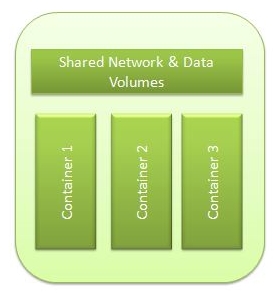Kubernetes
Kubernetes is an open source tool for orchestrating containers in a cluster. It supports different container technologies including Docker and rkt. It was initially designed by Google and was based on its internal cluster management project Borg and was named Project Seven. It was then passed on to Cloud Native Computing Foundation as an initial technology in July 2015.
Key components
There are some key components and terminologies you will encounter while using Kubernetes. These are as follows.
Pods
A pod is one or more of a group of containers that are tightly coupled to each other. The container can be based on any framework, such as Docker, rkt, and so on. It the smallest deployable unit. It also has shared network and data volumes. The following screenshot illustrates the internal structure of a pod:

Internal structure of a pod
A pod has its own routable IP address, but it is not a requirement that it always has the same address. For example, if a failure occurs and a pod has...


































































